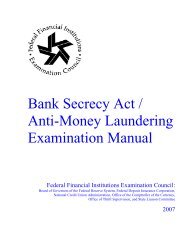FFIEC Annual Report 1999
FFIEC Annual Report 1999
FFIEC Annual Report 1999
Create successful ePaper yourself
Turn your PDF publications into a flip-book with our unique Google optimized e-Paper software.
and investments in mutual funds<br />
and simplified the agencies’ leverage<br />
capital rules for banks and<br />
thrifts.<br />
Recourse, direct credit substitutes, and<br />
securitizations. In August <strong>1999</strong>, the<br />
task force approved submitting an<br />
interagency proposal to revise the<br />
risk-based capital treatment of<br />
recourse obligations, direct credit<br />
substitutes, and asset securitizations<br />
to the full Council for its consideration.<br />
The proposal builds on previous<br />
efforts by the agencies to<br />
improve the risk-based capital<br />
treatment of these transactions.<br />
At its September <strong>1999</strong> meeting, the<br />
Council approved recommending<br />
to the agencies that they issue the<br />
revised proposal for public comment.<br />
The proposal is expected to<br />
be published in the first quarter of<br />
2000.<br />
Uniform Retail Credit Classification<br />
and Account Management Policy<br />
On February 10, <strong>1999</strong>, the <strong>FFIEC</strong><br />
issued the Uniform Retail Credit<br />
Classification and Account Management<br />
Policy, which updates and<br />
expands the classification guidelines<br />
for consumer loans that were first<br />
issued in 1980. The policy, among<br />
other things, sets forth guidance on<br />
the treatment of loans to bankrupt<br />
borrowers, fraudulent loans, loans<br />
to deceased borrowers, delinquent<br />
residential real estate and home<br />
equity loans, and partial payments.<br />
The policy also details the criteria<br />
that must be satisfied before a<br />
depository institution may consider<br />
a delinquent account current. The<br />
policy statement becomes effective<br />
on December 31, 2000, although the<br />
agencies are giving further consideration<br />
to certain issues raised by the<br />
statement.<br />
Interagency Policy Statement on<br />
External Auditing Programs of Banks<br />
and Savings Associations<br />
In September <strong>1999</strong>, the <strong>FFIEC</strong> issued<br />
an Interagency Policy Statement on<br />
External Auditing Programs of<br />
Banks and Savings Associations.<br />
The policy statement reflects the<br />
agencies’ view that accurate financial<br />
reporting is essential to an<br />
institution’s safety and soundness.<br />
To help ensure that financial statements<br />
and regulatory reports are<br />
accurately and reliably prepared,<br />
the policy statement recommends<br />
that banks and savings associations<br />
with less than $500 million in total<br />
assets establish and maintain an<br />
external auditing program as a part<br />
of their overall risk-management<br />
process. An external auditing program<br />
performed by an independent<br />
public accountant complements<br />
the internal audit function<br />
of an institution by providing an<br />
independent and objective view<br />
of the reliability of the institution’s<br />
financial statements and the<br />
adequacy of its financial reporting<br />
internal control. The policy statement<br />
also encourages the board<br />
of directors of each institution to<br />
establish an audit committee consisting<br />
entirely of outside directors.<br />
The policy statement is effective<br />
for fiscal years beginning on or<br />
after January 1, 2000.<br />
Other Areas of Coordination<br />
Elimination of Duplicative Filings<br />
In January <strong>1999</strong>, the agencies implemented<br />
the Interagency Bank<br />
Merger application form, developed<br />
as part of their effort to eliminate<br />
duplicative filings as directed by<br />
section 304 of the CDRIA. The new<br />
form replaces each agency’s merger<br />
application form. The agencies are<br />
also in the process of renewing the<br />
Interagency Change in Control notification<br />
form, which is filed by individuals<br />
seeking to acquire control of<br />
a bank or bank holding company.<br />
Interagency Guidance on Subprime<br />
Lending<br />
In February <strong>1999</strong>, the task force<br />
approved interagency guidance on<br />
subprime lending developed by a<br />
working group composed of staff<br />
from each of the four federal bank-<br />
ing and thrift agencies. Each agency<br />
issued the guidance in March <strong>1999</strong>.<br />
The guidance was developed to<br />
bring greater attention to the supervisory<br />
issues related to banks’ and<br />
thrifts’ involvement in subprime<br />
lending and to the way these institutions<br />
should manage the unique<br />
risks associated with this activity.<br />
As discussed in the guidance, if<br />
the risks associated with subprime<br />
loans are not properly managed, the<br />
agencies consider subprime lending<br />
to be a high-risk activity that is<br />
unsafe and unsound. The <strong>1999</strong><br />
interagency guidance advances<br />
sound practices for managing the<br />
risks involved in subprime<br />
lending. Institutions are expected<br />
to have policies and procedures in<br />
place to measure, monitor, and control<br />
the additional risks associated<br />
with this activity.<br />
Joint Policy Statement Regarding<br />
Branch Closings by Insured Depository<br />
Institutions<br />
On June 29, <strong>1999</strong>, the agencies<br />
issued a revised joint policy statement<br />
regarding branch closings by<br />
insured depository institutions. The<br />
revised statement incorporates<br />
changes in the underlying statute<br />
made by section 106 of the Riegle-<br />
Neal Interstate Banking and Branching<br />
Efficiency Act of 1994 and section<br />
2213 of the Economic Growth<br />
and Regulatory Paperwork Reduction<br />
Act of 1996. The policy clarifies<br />
the additional steps regarding<br />
notice and consultation for proposed<br />
branch closings by interstate<br />
banks in low- or moderate-income<br />
areas and clarifies the status of automated<br />
teller machines, relocations<br />
and consolidations, and branch closings<br />
in connection with emergency<br />
acquisitions or assistance by the<br />
FDIC.<br />
Asset Securitization Activities<br />
On December 13, <strong>1999</strong>, the agencies<br />
issued supervisory guidance<br />
emphasizing the importance of<br />
fundamental risk-management<br />
practices that govern securitization<br />
19
















